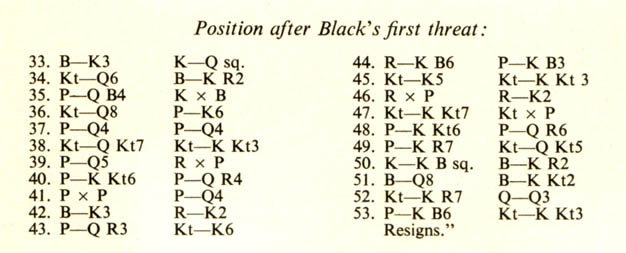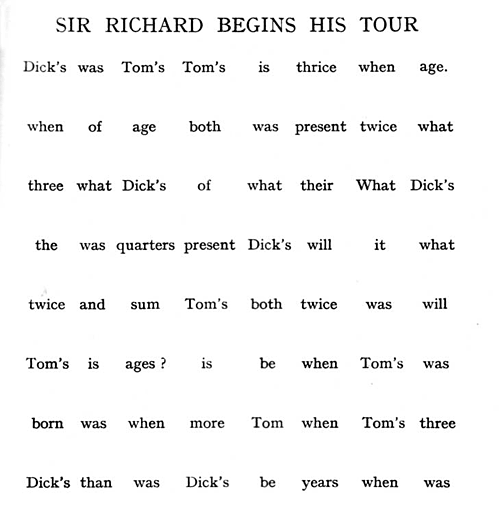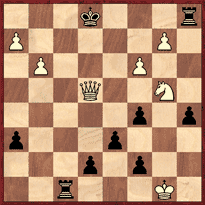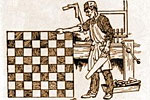Chess Explorations (48)
By Edward Winter
A) Mutilated score-sheet

The Patzer, who moved only one pawn, was so mortified by his quick defeat that
he burned the score-sheet. Did he burn it enough to disguise how he was mated?
(This puzzle appeared in C.N. 4075, with a clue in C.N. 4084.)
B) Brunswick’s message
A tough old puzzle also from the days of the descriptive notation was given in C.N.
3530 (a clue being added in C.N. 3536):
‘Below is the “score” of a game found in A.D. Brunswick’s
rooms after his death under mysterious circumstances. It was in Brunswick’s
handwriting. At first it aroused no suspicions, but Inspector Snooper, a keen
chessplayer, saw at once that it was some sort of cryptogram.’


‘What was Brunswick’s message?’
Source: pages 28-29 of Caliban’s Problem Book by Hubert Phillips
(‘Caliban’), S.T. Shovelton and G. Struan Marshall (London, 1933).
C) A mathematical puzzle
Below is the first in a series of puzzles from C.N.s 3537, 3551 and 3555:
‘The competitors in the Rookwood Chess Congress are organized in two
sections. In each section each competitor plays one game against each of the
other competitors in that section.
This meant, last year, that the secretary had to arrange 165 games. This
year there is one more competitor in each section.
How many games must the secretary arrange?’
Sources: page 198 of Hubert Phillips’s Heptameron (London, 1945)
and page 66 of Phillips’s Problem Omnibus Volume 1 (London, 1960).
D) Sir Richard begins his tour

Source: page 81 and pages 231-232 of Caliban’s Problem Book by
Hubert Phillips (‘Caliban’), S.T. Shovelton and G. Struan Marshall
(London, 1933).
E) Chess tournament
‘“For the purposes of our chess tournament”, said Woodpusher,
“we divided our players into two groups. Each player played two games
against each other player in his group. That did away with all possibility
of unfairness in regard to the opening move.”
“There must have been a large number of games played altogether.”
“Exactly 200”, said Woodpusher.
How many players in all took part in the tournament?’
Source: Problem Omnibus Volume 1 by H. Phillips (London, 1960), page
73.
F) 100-board match
‘Representatives of Doomshire and Gloomshire met to play chess over
100 boards. Both men and women players took part; each county producing more
than 50 men players.
More women played for Gloomshire than for Doomshire.
It was arranged that, so far as possible, men should be matched against men
and women against women. This meant that there were only mixed matches (men
versus women) to the extent to which the number of men players representing
Doomshire exceeded the number of men representing Gloomshire.
On the boards where men were matched against men, Doomshire won three matches
out of five. On the boards where women were matched against women, Gloomshire
won two matches out of three. And on the boards where Doomshire’s surplus
men met Gloomshire’s surplus women, the Doomshire players won two-thirds
of the matches. No game ended in a draw. The result was a very narrow win
for Doomshire by 51 games to 49.
How many men played for Doomshire?’
Sources: The Hubert Phillips Annual 1951 (London, 1950), page 160 and
Problem Omnibus Volume 1 by H. Phillips (London, 1960), page 87.
G) Giuoco Piano
‘“I’m competing”, said Gambitt, “in the Minor
Open Reserves at Prawnville.”
“Oh yes? Do you expect to win a prize?”
“Can’t say. There are four prizes altogether.”
“And how many competitors?”
“Twelve. But of course they may divide one or more of the prizes. Scoring
is on the usual plan, you see: one point for a win, half a point for a draw.
One year all 12 competitors scored five and a half points; the four prizes
were divided among them. Last year three competitors tied for first place
– they shared the first three prizes – then came three more competitors
with equal points; they divided the fourth place. So, you see, there’s
always a chance.”
“If I were you, Gambitt”, I said, “I wouldn’t be
too ambitious. Aim at scoring just enough points to be certain of at least
a share in a prize.”
“Good idea”, said Gambitt, “but how many points is that?”
How many points is it?’
Source: Problem Omnibus Volume 1 by H. Phillips (London, 1960), pages
114-115.
H) Wrong number
‘When Mrs Orme went into the nursery the children were playing with
the chessmen.
“What are you doing, dears?”
“Why”, said Ronnie, “Clara and I were talking about our
phone number. Clara says it has 32 pairs of factors.”
“So it has”, said Mrs Orme, who had worked that out herself.
“But why the chessmen?”
“There are 32 of those”, said Ronnie. “I was putting one
back in the box as I worked each pair of factors out. But, Mummy, there’s
something wrong. I’ve finished my calculations, and there are still
these eight black pawns.”
Mrs Orme took a hasty glance at his notebook. “Ronnie”, she said,
“you are a duffer. You’ve got the number wrong.”
“Got the number wrong?” echoed Ronnie.
“Of course. You wouldn’t call yourself Rome, now would you?”
What is the Ormes’s phone number?’
Source: Problem Omnibus Volume 1 by H. Phillips (London, 1960), pages
119-120.
I) Secret Service
‘During the recent rebellion in Jehannum, a native runner was brought
into the small fortified station of Ustaraf, which was occupied by a detachment
of the Wellshires, and was found to be carrying in the folds of his pagri
a tightly-folded paper, which he gave up without demur. The only writing on
it was the following:

Major ffeatherstonehaugh-Haugh, a keen but incompetent chessplayer, who was
in command, was greatly interested, and guessed that it must be a chess problem
sent to him by Legge-Pullar, who had taught him the rudiments of the game,
and whom he knew to be on Intelligence duty somewhere in the interior. He
therefore set himself to solve the problem, which seemed to be rather unusual;
so unusual, in fact, that three days later he had made nothing of it when
another runner was brought in, bearing a paper on which the following was
written:
AHAMIT TOT THAR TINALI EFAI ETCHL KRPS SOTTURA EPASTAI APONRR NIWDSIN IHLGT.
Major ffeatherstonehaugh-Haugh regrets he is unable to make head or tail
of this, and begs you to translate it for him, as he is not familiar with
any Oriental language.’
Source: Caliban’s Problem Book by H. Phillips (‘Caliban’),
S.T. Shovelton and G. Struan Marshall (London, 1933), pages 59-60.
J) Eques enucleat castaneam
‘When I met Professor Graeme Atta the other day he showed me an interesting
old manuscript book which he had come across when he was browsing among the
second-hand bookstalls in Charing Cross Road. The book plate was almost indecipherable,
but as far as I could make out bore the inscription “ex libris Samueli
Loyd”. One of the pages contained a curious Latin cryptogram which seems
to be of more than passing interest. Here is a copy of it:

Quot annos nata est Maria?’
Source: Caliban’s Problem Book by H. Phillips (‘Caliban’),
S.T. Shovelton and G. Struan Marshall (London, 1933), page 127.
K) Sawing the chessboard
Now, a problem by Sam Loyd given in C.N. 3596:

‘This clever young carpenter received a chest of tools for a Christmas
present, and immediately set to work to make a fine chessboard to present
to Dr Lasker, the chess champion of the world. Dr Lasker is a great mathematician
and puzzlist as well as a marvelous chessplayer, but can he beat our puzzlists
in discovering the largest number of different pieces that the carpenter could
have used in making this board?
Each piece must be made up of squares. One piece can be a single black square,
another piece a single white square. Only one piece may consist of two squares,
because all two-square pieces are alike. But a three-square piece has four
different forms – a straight row with a black square in the middle,
a straight row with a white square in the middle, a crooked piece with one
black square, and a crooked piece with one white square. When you have divided
the checkerboard into the greatest number of pieces, you will have solved
the puzzle.’
L) Setting up the pieces
Finally, a puzzle by Henry Ernest Dudeney, from C.N. 3644:
‘I have a single chessboard and a single set of chessmen. In how many
different ways may the men be correctly set up for the beginning of a game?
I find that most people slip at a particular point in making the calculation.’
Source: Amusements in Mathematics by H.E. Dudeney (London, 1917), page
105.
All the solutions can be found in the pages of Chess Notes, and a complete
list of relevant C.N. items is given under ‘Puzzles’ in our Factfinder.
For biographical and other information about Hubert Phillips, see The
Chess-loving Puzzle-master. A further problem by him (‘Living-chess
puzzle’) appeared on pages 71-72 of Chess Facts and Fables.
Submit information
or suggestions on chess explorations
All ChessBase articles
by Edward Winter
 Edward
Winter is the editor of Chess
Notes, which was founded in January 1982 as "a forum for aficionados
to discuss all matters relating to the Royal Pastime". Since then, over 6,760
items have been published, and the series has resulted in four books by Winter:
Chess
Explorations (1996), Kings,
Commoners and Knaves (1999), A
Chess Omnibus (2003) and Chess
Facts and Fables (2006). He is also the author of a monograph
on Capablanca (1989).
Edward
Winter is the editor of Chess
Notes, which was founded in January 1982 as "a forum for aficionados
to discuss all matters relating to the Royal Pastime". Since then, over 6,760
items have been published, and the series has resulted in four books by Winter:
Chess
Explorations (1996), Kings,
Commoners and Knaves (1999), A
Chess Omnibus (2003) and Chess
Facts and Fables (2006). He is also the author of a monograph
on Capablanca (1989).
Chess Notes is well known for its historical research, and anyone browsing
in its archives
will find a wealth of unknown games, accounts of historical mysteries, quotes
and quips, and other material of every kind imaginable. Correspondents from
around the world contribute items, and they include not only "ordinary readers"
but also some eminent historians – and, indeed, some eminent masters. Chess
Notes is located at the Chess
History Center. Signed copies of Edward Winter's publications are
currently available.

























 Edward
Winter is the editor of
Edward
Winter is the editor of 




